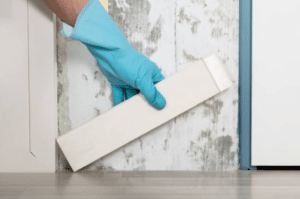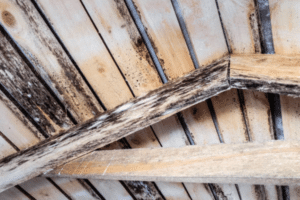If you own or operate a warehouse, you understand the importance of providing a safe and secure space to store goods.
However, one issue that you may not have considered is the growth of mould. Mould is a common problem in UK warehouses, and it can cause serious damage to your stored items and pose a health hazard to your staff.
In this article, we will provide you with top tips for preventing and eliminating mould growth in your storage units.
Key Takeaways
- Mould growth in warehouses can damage stored items and pose health hazards to staff.
- Common causes of mould in warehouses include high humidity levels, poor ventilation, water leaks, and inadequate insulation.
- Effective prevention strategies include maintaining proper ventilation, controlling humidity levels, conducting regular inspections, and addressing any water leaks promptly.
- Hiring professionals experienced in mould detection is crucial for conducting thorough inspections and safe mould removal.
- Investing in effective warehouse infrastructure and educating staff on mould prevention are important in maintaining a mould-free facility.
Statistics and Data on Mould in Warehouses
Consider these statistics and data if you’re dealing with mould in warehouses.
- According to a recent study by the British Property Federation, 40% of warehouses in the UK have experienced mould growth.
- Maintaining a humidity level of 60% or below can be done to prevent mould growth in warehouses.
- The average cost of mould remediation in a warehouse is £10,000.
- The average time to remediate mould in a warehouse is 6 weeks.
- Mould can cause productivity losses of up to 20%.
- Mould can lead to employee absenteeism of up to 10%.
Mould is a growing problem in warehouses in the UK and can have a number of negative consequences for warehouses
Understanding the Causes of Mould Growth in Warehouses
If you want to prevent mould growth in your warehouse, you need to understand what causes it in the first place.
Mould typically thrives in environments with high humidity levels and poor ventilation. These conditions can create a breeding ground for mould spores to spread rapidly and easily.
In addition to high humidity levels and poor ventilation, water leaks and inadequate insulation can also contribute to mould growth in warehouses.
Water leaks can raise humidity levels and lead to damp conditions, while inadequate insulation can cause condensation to form on walls and other surfaces, creating ideal conditions for mould to grow.
Identifying the Causes of Mould Growth in Warehouses
To effectively prevent mould growth, it’s important to identify the root causes.
Conduct thorough inspections of your warehouse, paying close attention to areas with poor ventilation, water damage, or signs of condensation.
Use moisture meters and other monitoring tools to identify areas with excess humidity levels.
Address any issues with ventilation or insulation promptly, and fix any leaks or water damage as soon as possible.
Implementing proactive measures to prevent mould growth can save you time and money in the long run, as it can help prevent damage to your stored items and potential health risks for employees.
Implementing Effective Mould Prevention Strategies in Warehouses
To prevent mould growth in your warehouse, follow these effective strategies:
Control humidity levels: Keep humidity levels between 30-50% to prevent moisture buildup. Use dehumidifiers or air conditioners to regulate humidity levels.
Maintain proper ventilation: Ensure adequate air flow throughout the facility to prevent stagnant air and humidity buildup. Clean air ducts regularly and consider installing exhaust fans in areas prone to moisture buildup.
Organise inventory: Poorly organised inventory can create mould-friendly conditions. Keep items spaced apart and off the floor to ensure proper air flow.
Address water leaks promptly: Water leaks can quickly lead to mould growth. Inspect for leaks regularly and repair them as soon as possible.
Conduct regular inspections: Regular visual inspections can help detect mould growth early on. Keep an eye out for signs of moisture, such as water stains or condensation.
Use moisture-resistant materials: Use materials that resist moisture, such as plastic storage containers or metal shelving units. Avoid using materials that absorb moisture, such as cardboard boxes or wooden pallets.
By implementing these strategies, you can effectively prevent mould growth in your warehouse and maintain a healthy storage environment.
Conducting Regular Warehouse Mould Inspections
To effectively prevent and address mould growth in your warehouse, it is crucial to conduct regular mould inspections.
Visual assessments, moisture measurements, and air quality testing are essential to identify areas of concern and take appropriate action.
During a visual assessment, look for signs of water damage, leaks, and condensation. Inspect any areas where moisture may accumulate, such as corners, behind equipment, and inside ductwork.
Moisture meters and hygrometers can be used to measure moisture levels and identify potential problem areas.
Air quality testing can also help identify the presence of mould spores in the air. This is important because mould can grow in hidden areas where it may not be visible, such as inside walls or under flooring.
Professional mould inspectors have the experience and expertise to conduct thorough and accurate assessments.
If you suspect or have identified a mould problem, it is important to address it promptly. Delaying remediation can lead to further damage to stored items, as well as potential health risks for warehouse staff and visitors.
Choosing a Professional Mould Removal in Warehouses
If you have detected mould growth in your warehouse, it is crucial to address the issue promptly and effectively.
Attempting to remove mould without proper knowledge and equipment can pose health hazards and may result in further damage.
That’s why it’s important to hire a professional mould cleaning service for warehouse remediation.
These experts have the experience, equipment, and knowledge necessary to safely and effectively eliminate mould growth and prevent its recurrence.
When choosing a professional mould removal service, look for a company with a proven track record of success in warehouse mould remediation. Ask about their experience, certifications, and the techniques they use.
It’s also important to consider the company’s availability and the timeline for the project. Choose a service that can work around your schedule and provide prompt service to minimise disruption to your warehouse operations.
At AirFresh Mould Removal London, we pride ourselves on expert and professional warehouse mould removal.
Our team of experienced technicians uses state-of-the-art equipment and techniques to effectively remediate mould growth and prevent its recurrence.
Contact us today to schedule a consultation and take the first step towards a mould-free warehouse.
Effective Methods for Warehouse Mould Removal
When it comes to warehouse mould removal, effectiveness and thoroughness are essential. Here are some proven methods for getting rid of mould in warehouses:
| Method | Description |
|---|---|
| HEPA Vacuuming | A high-efficiency particulate air (HEPA) vacuum can effectively remove mould spores from surfaces and the air. The vacuum should be equipped with a HEPA filter to prevent spores from escaping into the air. |
| Surface Cleaning with Antimicrobial Agents | Antimicrobial agents can be used to disinfect surfaces contaminated with mould. It’s important to use the appropriate antimicrobial agent for the type of mould present and to follow manufacturer instructions for use. |
| Air Scrubbing | An air scrubber can be used to capture and remove mould spores from the air. This equipment is particularly useful for larger warehouse spaces where airborne mould spores may be more difficult to control. |
It’s important to note that simply removing visible mould is not always enough. Mould can grow in hidden areas, such as within wall cavities or behind ceilings.
Professional mould specialists can use specialised equipment like thermal imaging cameras to identify such areas and ensure complete removal.
After mould removal, it’s crucial to address the underlying issues that caused the mould growth in the first place.
Any water leaks should be addressed promptly, and humidity levels should be monitored and controlled. Proper ventilation and storage practices can also help prevent mould recurrence.
Maintaining Mould-Free Warehouses
To maintain a mould-free warehouse, it is crucial to conduct regular inspections, repairs and continuous monitoring of humidity levels.
Here are some essential tips for keeping your warehouse free from mould:
Conduct regular inspections: Regular inspections help identify mould-friendly conditions and prevent mould recurrence.
Repair water leaks promptly: Water leaks contribute to high humidity levels, creating ideal conditions for mould growth. Timely repairs help prevent mould development.
Control humidity levels: High humidity levels encourage mould growth. Keep humidity levels below 60% to prevent mould development.
Use dehumidifiers: Dehumidifiers can help control humidity levels in the warehouse.
Proper ventilation: Proper ventilation helps maintain adequate airflow, reducing humidity levels and preventing mould growth.
Organise inventory: Proper storage prevents mould-friendly conditions such as overcrowding, poor airflow and humidity trapping.
Monitor humidity levels: Regular monitoring of humidity levels can identify potential mould growth conditions and help prevent its development.
Implementing these measures can help maintain a mould-free warehouse, protecting the stored items and ensuring a healthy environment.
Educating Warehouse Staff on Mould Prevention
As an owner or manager of a warehouse, it is essential to educate your staff on mould prevention strategies to maintain a healthy environment for stored items and employees.
Proper staff training is crucial in preventing mould growth and spread. You should consider providing training on proper storage practices, ventilation, and identifying early signs of mould growth. Ensure all staff understand the need to report any leaks or mould sightings immediately.
It is also important to emphasise the role of staff in maintaining a mould-free facility. Educate your employees on the consequences of poor storage practices, such as piling items against walls or storing them in damp areas.
Proper cleaning and maintenance practices must also be discussed during staff training.
By educating your staff and providing them with the necessary training, warehouse owners can ensure a mould-free environment and protect their stored items and employees’ health.
Investing in Effective Warehouse Infrastructure
To prevent mould growth in your warehouse, it is essential to invest in effective infrastructure. Proper insulation, moisture barriers, and ventilation systems are all crucial components of a mould-resistant environment.
By improving your warehouse infrastructure, you can reduce the risk of mould growth and protect your stored items from damage.
Insulation is key for maintaining consistent temperature and humidity levels. When the temperature drops in winter, insulation can help keep your warehouse warm and prevent condensation from forming on surfaces.
Moisture barriers, such as sealants or waterproof coatings, can help prevent water from seeping into your warehouse and creating damp conditions that promote mould growth.
Effective ventilation systems are also important for controlling humidity levels and preventing the build-up of moisture.
Proper ventilation helps to circulate air and remove excess humidity, reducing the risk of mould growth.
If your warehouse lacks sufficient ventilation, consider investing in a dehumidifier or installing additional ventilation systems.
Monitoring and Early Detection of Mould Growth
Effective mould prevention involves monitoring storage units for early detection of mould growth.
This helps in identifying potential mould-friendly conditions and acting promptly to prevent further damage.
One way to monitor your warehouse for mould is by using moisture meters and other monitoring tools. These devices help in identifying areas with high humidity levels, which can trigger mould growth.
Regular inspections of the warehouse, especially after heavy rain or flooding, are also important.
If you notice any signs of mould growth, such as a musty odour or discoloured spots, it’s crucial to take quick action.
Early detection and treatment of mould help in preventing further damage and minimising the risk of health issues.
Remember, mould can grow quickly, and it’s more challenging and expensive to remove once it spreads.
Always be proactive in monitoring and early detection in your warehouse to prevent this from happening.
Conclusion
As a warehouse owner or manager, it’s crucial to take proactive measures to prevent and eliminate mould growth in your storage units.
Not only can mould damage your stored items, but it can also pose significant health risks to your staff.
By understanding the causes of mould growth and implementing effective prevention strategies, you can maintain a healthy and safe storage environment.
Regular inspections are also an essential part of mould prevention, and hiring professionals experienced in mould detection is recommended to ensure thorough and accurate inspections.
In the event of mould growth, it’s crucial to hire a professional mould experts like AirFresh Mould Removal London for safe and effective remediation.
Encourage your warehouse staff to participate in mould prevention measures by providing training on proper storage practices and reporting of leaks or mould sightings.
Consider investing in infrastructure improvements to create a mould-resistant environment for your storage units.
By monitoring for early detection and taking prompt action, you can prevent further damage and maintain a mould-free facility.
Take the necessary steps to tackle mould growth in your UK warehouse today, and protect your stored items and staff from potential harm.
FAQ
Q: What are the common causes of mould in warehouses?
A: Mould growth in warehouses is often caused by factors such as high humidity levels, poor ventilation, water leaks, and inadequate insulation.
Q: How can I prevent mould growth in my warehouse?
A: Implementing effective mould prevention strategies includes maintaining proper ventilation, controlling humidity levels, conducting regular inspections, and addressing water leaks promptly.
Q: Why is conducting regular warehouse mould inspections important?
A: Regular inspections help detect and prevent mould issues in warehouses by assessing visual signs, measuring moisture levels, and conducting air quality testing.
Q: Is it necessary to hire a professional mould removal service for warehouse remediation?
A: Yes, hiring a professional mould removal service is crucial for safe and effective mould elimination, as attempting removal without proper knowledge and equipment can pose health risks.
Q: What are effective methods for warehouse mould removal?
A: Effective methods for warehouse mould removal include HEPA vacuuming, surface cleaning with antimicrobial agents, and the use of specialised equipment like air scrubbers to prevent regrowth.
Q: How can I maintain a mould-free warehouse?
A: Maintaining a mould-free warehouse requires regular inspections, prompt repairs of leaks or damage, and continuous monitoring of humidity levels to prevent mould recurrence.
Q: How can I educate my warehouse staff on mould prevention?
A: Educating warehouse staff on proper storage practices, the importance of ventilation, and prompt reporting of leaks or mould sightings is crucial in maintaining a mould-free facility.
Q: Is investing in warehouse infrastructure improvements necessary for mould prevention?
A: Yes, investing in proper insulation, moisture barriers, and effective ventilation systems is essential for preventing mould growth in warehouses.
Q: How important is monitoring and early detection of mould growth in storage units?
A: Monitoring storage units for early detection of mould growth using moisture meters and other tools is crucial to prevent further damage and address mould issues promptly.
Are you concerned about mould in your warehouse? We can help you get rid of the mould and prevent it from coming back.
Call us today on 0203 130 4068 for a free consultation.






